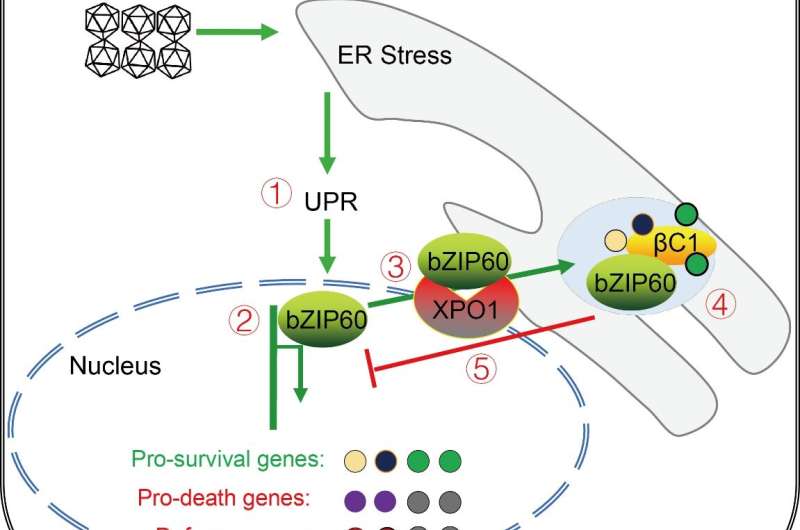This article has been reviewed according to Science X's editorial process and policies. Editors have highlighted the following attributes while ensuring the content's credibility:
fact-checked
peer-reviewed publication
trusted source
proofread
Researchers reveal how geminiviruses cause devastating disease in worldwide crops

Geminiviruses are a group of single-stranded circular plant DNA viruses that cause devastating diseases in many economically important crops including tomato, tobacco, cotton, corn, wheat, beans, and cassava worldwide. Due to their small genome size and limited coding capacity, geminiviruses rely heavily on host plants to complete their life cycle by exploiting/manipulating host components at different cellular levels.
Unfolded protein response (UPR) is a conserved response in eukaryotes to alleviate endoplasmic reticulum (ER) stress, which is involved in plant growth, development, and response to abiotic and biotic stress. UPR has diverse roles in plant-RNA virus interaction, but the mechanism in plant DNA viruses is still obscure.
In this study, researchers used a plant DNA virus, tomato yellow leaf curl China virus (TYLCCNV) and its associated tomato yellow leaf curl China betasatellite (TYLCCNB), as models to investigate the role of UPR in plant DNA viral infection.
Researchers' results show that TYLCCNV and TYLCCNB co-infection, or transient or stable expression of TYLCCNB-encoded βC1 can activate UPR and upregulate the expression of NbbZIP60. They provided evidence that demonstrates that induction of ER stress by dithiothreitol (DTT), a UPR inducer or overexpression of NbbZIP60 benefited TYLCCNV/TYLCCNB infection. Conversely, inhibition of the UPR reaction by tauroursodeoxycholic acid (TUDCA) or knocking down/out NbbZIP60 by tobacco rattle virus (TRV) -mediated gene silencing system/CRISPR-cas9 mediated gene knock-out-system attenuated TYLCCNV/TYLCCNB infection. Therefore, they speculate that NbbZIP60 of UPR is a pro-viral factor, in the case of TYLCCNV/TYLCCNB infection.
In order to analyze the possible interaction between βC1 and NbbZIP60, yeast two-hybrid (Y2H), bimolecular fluorescent complementary (BiFC) and co-immunoprecipitation (Co-IP) were used in this study. Researchers found that βC1 interacted with NbbZIP60 in the above assays.
Researchers also found that TYLCCNV/TYLCCNB infection or the overexpression of βC1 was able to induce the nuclear export of YFP-NbbZIP60. They further confirmed that the nuclear export of YFP-NbbZIP60 depended on the nuclear export protein- (XPO1) mediated nuclear export pathway.
Furthermore, the team found that the NbbZIP60-regulated pro-survival factors luminal binding protein NbBiP and calreticulin NbCRT promote TYLCCNV/TYLCCNB infection, while the pro-cell death factor NbNAC089 controlled by NbbZIP60 limits TYLCCNV/TYLCCNB infection.
These findings provide new knowledge on how geminivirus infection activates UPR and utilizes the host IRE/bZIP60 pathway via a cascade of protein-protein interactions to benefit virus infection.
More information: Mingzhen Zhang et al, Geminivirus satellite-encoded βC1 activates UPR, induces bZIP60 nuclear export, and manipulates the expression of bZIP60 downstream genes to benefit virus infection, Science China Life Sciences (2022). DOI: 10.1007/s11427-022-2196-y
Journal information: Science China Life Sciences
Provided by Science China Press




















